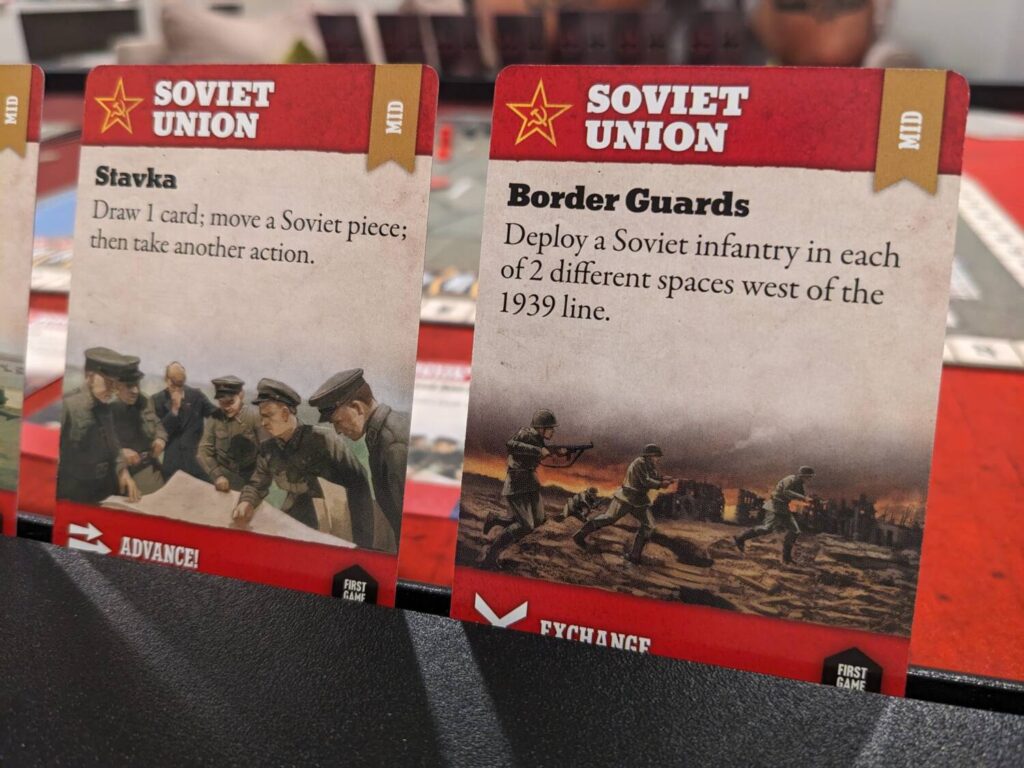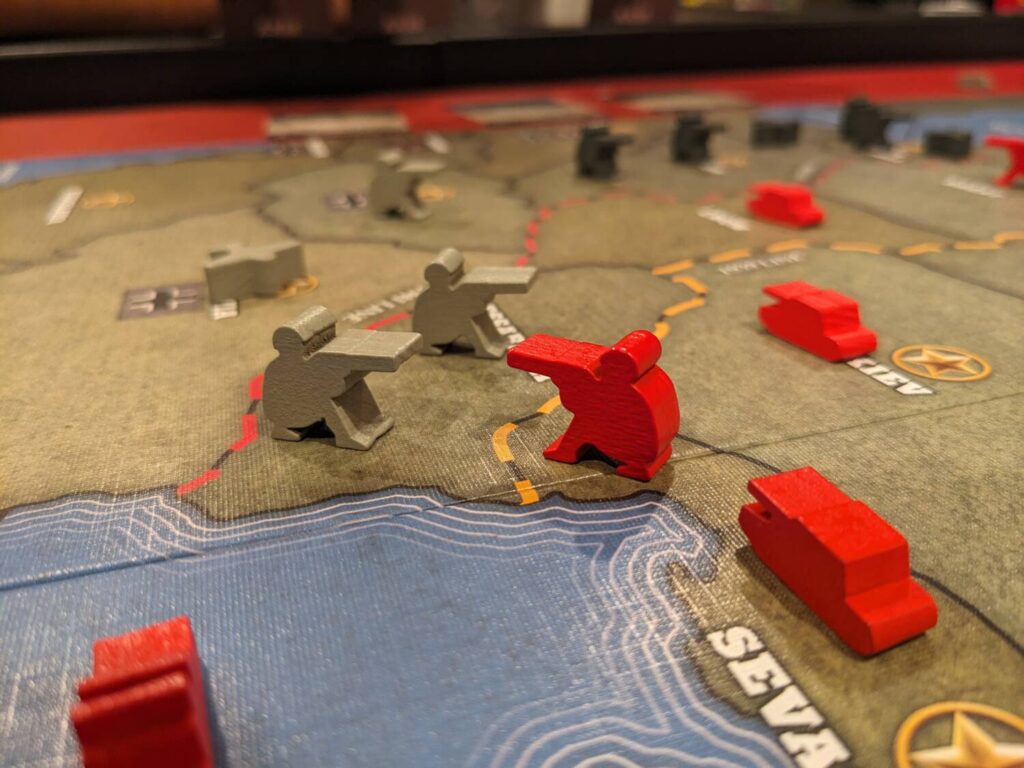Disclosure: Meeple Mountain received a free copy of this product in exchange for an honest, unbiased review. This review is not intended to be an endorsement.
“Ahh, we’re doing wargames now, eh?”
My buddy Kev and I were messaging each other because I asked him if he would try a two-player-only, card-driven war simulation called Quartermaster General: East Front. “No, but I love games that play in about an hour” was my immediate response, one that originated from the same reason why I raised my hand to try this game in the first place.
(A note about the game’s title: no, I am not sure why the game is called East Front, but not Eastern Front. Whenever I talked about this game, players wanted to call it Eastern Front. It’s not Eastern, it is East! I’m sure this is tied to the historical significance of the conflict, but still—I thought it was hilarious how often people got the name wrong.)
Quartermaster General: East Front (2023, Ares Games) distills the entire conflict of the Axis powers’ attempts to invade the Soviet Union during World War II in 1941 into a 90-minute asymmetric cardplay experience. One player takes on the role of the Allied forces of the Soviet Union, as the Soviets are forced to find ways to delay the onslaught of the Axis side while counterpunching their way through skirmishes throughout the western part of the region. The other player is the Axis, represented here by the Germans and the Tripartite Pact, a collection of late-to-the-party forces such as Finland and Romania bent on invading the Soviet Union to reclaim territory lost earlier in the war.

Quartermaster General: East Front (QG: EF) plays across a maximum of 16 rounds, where each side takes a turn trying to deploy and recruit infantry, tanks, planes and fleets to attack, defend, and counterattack their rival. The map features critical regions that factor into the scoring and at the beginning of the game, the Soviets control 10 of these “Victory Point Star” spaces, with the Axis powers controlling the remaining seven stars. That puts the onus on the Axis to blitz the East Front quickly to begin taking over positions so that when each of the game’s four scoring rounds take place, the Axis will hopefully control more star spaces than they began with.
Everything in the game is done using a deck of about 50 cards, and players use their cards to take advantage of their main card text to take actions, react to enemy maneuvers, and take other minor actions by simply discarding one or two cards from hand. Each player also has access to Contingency cards, which are double-sided cards that feature a single-use action. Once both actions of a Contingency card have been exhausted, that card is removed from play.
Players begin a turn by moving, then taking two actions and moving certain units a second time if they choose. Then, the series signature—checking supply lines to ensure active units can trace a supply line to one of their supply points on the map—takes place, and any unsupplied unit owned by the active player is immediately removed from play. Players then draw cards before their rival takes the next turn.
During a scoring round, if one side is 10+ points ahead of the other, they automatically win the game. Otherwise, the game keeps rolling until the fourth and final scoring round; if the game is tied at that point, the Axis side wins since they began the game at a disadvantage.

It’s Cold in Winter
QG: EF is exceptionally easy to teach, and now that I have shown this to three different opponents (Kev, my wife, and my Dusty Euros friend John), I must say that QG: EF gets a lot of things right.
Combat is great, and it is easy…if anything, everyone who joined me for a play said that they wished the game had a few more combat options on their cards. I love that planes and fleets are used to support battles instead of units that can instigate combat, so I was murdering off planes left and right to sustain fights in many cases. Combat is usually quick, and in a desperate spot, you can always discard two cards to start a fight somewhere, so combat is almost always lurking nearby.
The player aid is excellent and has proven to be all I have needed to both teach the game and refer back to certain icons during play. Setup and teardown is so easy…I am probably too accustomed to setting up monstrosities like Inventions: Evolution of Ideas, so when it only takes five minutes to set up a game, I’m a bit surprised that I have a lot of time to just, you know, play! Save for one minor meeple calamity—one of my German infantry units is missing its rifle—the production elements here are great.
The player aid provides a few notes on how to guide players, and there’s even a starter set of cards the game suggests using for a first play to get players into the action more quickly. For better and for worse, QG: EF is always going to play the same way—same map setup, same scoring discrepancy, same focus for each side to play its game the way it has to be played. That meant that even after playing as one side twice, I had a rhythm of what I wanted to try first or strategies that might work to establish myself with the initial board state.

The cards are balanced nicely and the varying order in which cards will appear in a player’s hand provides a lot of ways each game could play out. Further, the game’s best feature is watching players decide how to spend cards as reactions to their opponent’s attacks…playing cards in this way means they can’t be used on that player’s turn as the active player. How many great cards will I have to waste to ensure I can continue to hold Warsaw or another map position?
In this way, QG: EF reminded me most of the criminally-underrated Martin Wallace design Wildlands (2019, Osprey Games). In both games, your hand of cards is used for both offense and defense, and one of the most critical decisions on a turn can simply be whether a person can afford to spend any more cards defending themselves when new cards are not coming until the end of that person’s next turn! (In Wildlands, this is doubly interesting because you might have to defend yourself for 2-3 turns by other players before taking a turn of your own!)
Even better with QG: EF? When your draw deck is gone, it’s gone for the rest of the game! In my first play, both players ran out of cards just after the third scoring round (of four), so we did what we could for the remainder of the game then called it once we realized that we couldn’t do anything else interesting. I love that this is a thing. Making more careful decisions upfront can be so critical in this game, and having even a few cards more than the opponent means taking meaningful actions while the opponent can only watch.
QG: EF plays fast, but not as fast as it says on the back of the box. In my experience, games took about 90 minutes, not 60. Still weeknight gaming territory, just not as fast as I was hoping for.
My main negatives are tied to replayability…after three plays (two as the Axis, one as the Allied forces), I had seen enough of QG: EF and I’m sure I won’t go back to it. Now, if I had a partner or a roommate who would be willing to play this specific scenario all the time? OK, that would be a factor. But my wife saw it once and that single play was enough, and I don’t have regular two-player-only wargame nights at present. Depending on your circles, take that into consideration with this purchase.

Additional points of concern—some players just won’t have the mindset to be on the offensive for the entire game (i.e., my wife). For my wife, this ended up being OK because she was less interested in murdering off my troops and instead positioning ways to continue holding strategic regions and “eliminating” (removing without a combat action) some of my pieces to keep me at bay.
One last negative, which could go either way in the hands of other players: the rules around how the Axis powers operate by working as two separate but aligned forces are sometimes confusing. The Tripartite Pact, known as the Pact on certain cards, can only operate its pieces to do certain actions if the Axis player uses a Pact-specific card, versus a Germany action card. Also, everything in the game is piece-limited, and during my second Axis play, I was surprised how limiting things were because my opponent hadn’t killed off any of my Pact units.
On the one hand, the game is telling me to be more aggressive…I get it. But one could almost see a strategy behind the Allied player intentionally not fighting the Pact powers. On one of my turns, I had five cards but four of them were Pact cards and I found myself discarding cards to take less efficient actions in that round to clear my hand and get better options. The rules around how forces can operate with combined arms were just a little too tricky for my tastes. Not a gamebreaker, but the more experienced player should probably play as the Axis if two players have different experience levels with the system.
Otherwise, Quartermaster General: East Front is solid fare. It takes a critical moment in history and ably turns it into a game that can be played by almost anyone, including those of us with very little wargaming experience. Series designer Ian Brody does tight work here and now I’m even more excited to try the Quartermaster General base game!











